How—and When—to Include Projects on Your Resume (Plus Examples!)

If you’ve completed a project you’re especially proud of, it’s natural to want to show it off on your resume—and it might even help you land your next job. Projects that potentially belong on your resume can come from your past jobs, paid and unpaid side ventures, and—if you’re a recent grad—your academic coursework.
Read on to see why, when, and how you should put projects on your resume.

Why You Should List Projects on a Resume
Like everything else on your resume, projects can help highlight experiences that qualify you for your next job. You may have used skills— hard or soft —in a certain project that are key for the role you want. And including a successful project is a great way to tie those skills directly to results, which employers want to see on every resume.
When You Should List Projects on Your Resume
Adding projects to your resume “can be a great way to highlight experience outside of your daily role, enhance a recent grad resume, or bridge the gap from what you’re doing to what you want to do” if you’re looking to change or pivot careers, says Muse career coach Tara Goodfellow , owner of Athena Consultants .
Projects are an especially helpful addition to your resume when your experience section doesn’t already show that you have the background you need to get the job you want next, which is most common for two groups of job seekers:
- Recent graduates : Entry-level candidates by definition lack professional experience. But if you just finished college, a big project—whether you did it for a class, an honors or capstone program, an internship, or your own research—can show that you have a lot of valuable workplace skills such as leadership, collaboration, presentation, and public speaking, Goodfellow says. After your first-full time role, Goodfellow recommends removing school projects from your resume.
- Career changers or pivoters: When you’re looking to switch or pivot your career, you want to show any experience you have that relates to the role, field, or industry you want to go into. This might mean highlighting projects you did within a current or past job or adding a volunteer, side, or freelance project to your resume. What matters is that your project helps prove to employers you have relevant experience for the job you’re hoping to land.
Which Projects You Should Include
When you’re deciding which projects to add to your resume, “you want to be strategic,” Goodfellow says. “Don’t just dump every project you've been part of hoping something will catch the hiring manager’s attention.” Instead, carefully go over the job description for any role you’re interested in. Highlight any skills or qualifications the company is looking for that you have, as well as any job duties they list for the role that you’ve performed in the past. Then note any that can only be proven by including a certain project on your resume. If a project doesn’t meet this threshold, it probably doesn’t need to be called out.
Even if you’re in a more project-based field, like engineering, IT, or consulting, consider whether all or any of your projects can emphasize your accomplishments in a way that general bullet points under each job entry can’t. With too many projects crowding your resume, recruiters might not find the most important details. For example, if you generally do consulting for larger clients, but once worked with a small business and got great results, listing details for that one project might help you land a job at a consultancy with a small-business focus. But if most of your clients are small businesses, mentioning a slew of individual projects rather than overall achievements will take up valuable resume space without necessarily adding to your qualifications.
How to List Projects (Plus Examples)
List your projects wherever they’re most relevant, Goodfellow says. For recent grads, this often means your education section. If the project was part of a past job, freelance work, or volunteer work, it likely belongs under that specific entry in your experience section . If you’re thinking of a personal or side project or you have multiple projects that you want to include on your resume, you might consider adding a dedicated “Related Projects” or similarly titled section.
Regardless of where you list your project, you should follow these general tips:
- Include important details. You should add enough information about each project that it can be easily understood by anyone who reads your resume. Depending on the specific project, consider listing a project title, a project description, and project dates, as well as who you did the project for and with, what your role was, and what the results and impact were.
- Focus on your achievements. Whether your project description is contained to one bullet point or has several bullet points underneath it, employers want to see what results you’ve gotten with your skills so they can see how you might drive results for them. Use achievement-oriented , quantified bullet points to really put your accomplishments front and center.
- Tailor your project description for every job application. You should only include projects that are relevant to the specific job you’re applying for and, even more than that, you should make sure your description of a project highlights the pieces of it that are most relevant. So if a company is looking for someone with website design experience, focus on the design aspect of your side project, not how you attracted customers to your site. And try to use the same language and keywords as the job description.
- Include links to your work when possible. Almost everyone who reads your resume will do so for the first time on a computer, so links to work that’s live online are fair game. Just make sure you hyperlink an unimportant word like “Project” or even “Link” to avoid any applicant tracking system (ATS) issues.
What does this all look like in practice? Here are a few examples based on where you’re listing a project.
In an Education Section
This is how an entry-level applicant looking to emphasize their research, writing, and presentation skills might include a project on their resume.
Bachelor of Arts in English | Colgate University | Hamilton, NY Expected Graduation: Spring 2021 Capstone Project: “Voices Missing From the 19th-Century Literary Canon”
- Wrote a 40-page dissertation on three minority writers who are not commonly taught in U.S. K-12 schools or colleges, exploring literary devices and techniques used before other writers who are commonly taught
- Presented research findings at Nineteenth-Century Studies Association 2021 Conference as one of five undergrads selected to give a 10-minute talk
- Researched writers’ lives and work by analyzing newspaper archives (via LexisNexis), conducting interviews with literary scholars who focus on the 19th century, and traveling to review old correspondence and writings not widely reproduced
- Analyzed 12 total texts to compare literary devices and techniques between focal writers and their contemporaries
Within Your Experience Section
Here’s how a marketer looking to pivot into project management might include a project under a past job immediately after the bullet points describing their overall duties and accomplishments.
Key Project
- Led $200k digital marketing campaign from conception to launch, resulting in 120% of target signups in first two months of campaign
- Managed cross-functional team of seven marketing coordinators and analysts, content creators, and designers through market research, content creation, campaign launch, and analysis of results, setting deadlines, adjusting to changes in schedule, and resolving conflicts and miscommunications among teams
Within a Dedicated Section
Here’s how an aspiring software engineer might describe a project they did in their free time to show off their coding chops to prospective employers.
RELEVANT PROJECTS
TheTradingPost.com | March 2020–September 2020 | Link
- Designed and coded a website (using CSS, Python, and JavaScript) where players of popular video games could arrange trades for virtual items, receiving an average of 1000 hits monthly
- Responded to user feedback and issues to improve site functionality and build additional features including a search function
Protect your data
This site uses cookies and related technologies for site operation, and analytics as described in our Privacy Policy . You may choose to consent to our use of these technologies, reject non-essential technologies, or further manage your preferences.
- Resume and Cover Letter
- How to List Projects on a...
How to List Projects on a Resume (with Examples)
10 min read · Updated on February 23, 2024

Projects on your resume can prove you have what it takes to succeed
You've likely heard a few catchphrases related to resume writing. Things like “show, don't tell” and “be an achiever, not a doer.” One of the most effective ways to put these principles into action is by including projects on your resume. But how exactly do you list projects on a resume, and why are they so important?
You've come to the right place. Here, you'll learn how to list projects on your resume in a way that catches the eye of hiring managers and helps you to stand out from the competition.
It doesn't matter if you're fresh out of college or have a decade of experience under your belt; including projects on your resume can significantly enhance your chances of landing your dream job.
Your old resume may have been a list of work experiences, but your new resume will outshine the competition and win you the interviews you seek.
Projects vs work experience
Depending on where you're at in your career, it can be tough to separate projects from actual work experience, especially if you're a freelancer or regularly tackle projects as a part of your job. While both are exceedingly valuable in telling your career story, you have to be a bit discerning to determine which is more important.
Obviously, you gain experience from working at jobs and completing projects, but listing projects separately can help you to highlight specific skills that might get lost when you explain work you did in a previous job.
The main differences can be summarized as:
Projects are concise and specific
Work history provides a broader view of your career trajectory
At the end of the day, you must pick the things you want to include on your resume with the aim of balancing your knowledge and skills with what's being called for in the job description. Relevancy and tailoring your resume are critical, allowing prospective employers to see what you have to offer their team.
Why listing projects can be good for you
When you're trying to prove to an employer that you're an achiever rather than a doer, having a project or two to back up your claims can do wonders for your candidacy. Not only do projects on your resume have the ability to demonstrate relevant skills, but they also allow you to showcase initiative and accomplishments.
In the context of standing out from the crowd, projects on your resume can add depth to your experience to paint a more well-rounded and comprehensive picture of what you bring to the table for the new employer. One thing that a lot of people miss is that you can also use projects on your resume to fill in any experience gaps that may be present.
Types of projects you can highlight on your resume
While the projects you list on your resume are as unique as you are, there are some common types. Knowing what type of project you're going to list on your resume will help you to determine if the project is relevant and can also guide you in knowing where on your resume to list it.
There are four basic types.
This is any project you've done in your position with a company. It was probably part of your job description, but it could've also been something you were called on to do outside of your day-to-day role. Perhaps you led a team to launch a new product or created a new process for doing something that saved time and money. Work projects are good to have on your resume because they demonstrate that you're the type of person to go above and beyond to achieve an objective.
2. Academic
These are projects that you complete in a classroom or educational setting. You'll definitely need to include academic projects if you're fresh out of college and have little to no work history or relevant professional experience. Academic projects for your resume can be anything from conducting a research study and writing a thesis or dissertation to developing a software application as part of a class project. Including academic projects on your resume gives you a chance to highlight relevant skills and prove to a future employer that you have a passion for learning and development. After all, continuous improvement is a highly sought-after skill.
3. Personal
Sometimes, you get bored at home and decide you want to build a personal website or create a blog. There have even been folks who've created apps that work with their smart home devices to automate activities. It doesn't matter that these are personal projects, if you find that your resume is lacking particular skills or achievements you can use these projects on your resume to round out your candidacy. That said, adding a personal project to your resume should be a last resort.
4. Freelance
'Tis the time we live in – a lot of people work as independent contractors or freelance. It's a great way to fill in employment gaps or have some income if you're on a sabbatical . The most common freelance projects center around things like graphic design, marketing, tech, and writing. These types of projects can be valuable additions to your resume.
How to add projects to your resume
Since you want to keep your resume relevant to the job you're applying for, the first step is to create a list of projects from your history and compare them to what employers need.
Analyze the job description to dissect out the keywords and phrases. Once you have that list, compare it to the skills and achievements you can talk about with each project. Beyond picking the right project to match the job, you also have to consider space.
Bear these guidelines in mind:
Pick projects for your resume that match the job description
Pick projects that allow you to keep your resume on the right number of pages
The final step is to properly format the project entries in their respective sections.
Where to include projects on your resume
For the most part, you'll format a project listing the same way you would a work history listing. The only difference is that you may not have a company to list indicating where you did the project. If you can't list the client or location associated with the project, don't let that stop you from adding it.
As you would expect, work projects would be listed in the Professional Experience section, academic projects are best suited in the Education section, and some projects may even merit having their own special section.
What does all of that look like? Let's take a look.
Projects in their own section
For the most part, your resume should have at least five sections:
Contact information
Profile (which contains your title and summary paragraph)
Work history
You can also add an entirely new section called “Projects,” “Selected Projects,” “Relevant Projects,” or “Academic Projects.”
Depending on how hard you have to lean on those projects to wow a hiring manager will be the deciding factor on whether you place this new section above or below “Professional Experience.” If you really need them to make your candidacy, then put them above. If you want them on there just to give the hiring manager one more glimpse into what you can do, then put them below.
Example of projects in their own section
You should create a title for the section and then list each project with relevant bullet points that call out things you achieved in working on that project. It's also appropriate to put the dates you were working on each project.
Selected Projects
Post Evaluation Platinum LEED Office Building | 04/2022 - 10/2022
Used advanced knowledge of Occupant Indoor Environmental Quality (IEQ) Survey benchmarks and performed literature review / precedent studies to present data-driven solutions regarding visual and thermal comfort.
Authored and presented findings related to underfloor air distribution (UFAD) system analysis.
Integrated Façade Simulator: Hybrid Reality Simulations for Assessing Human Façade Interaction | 09/2020 - 05/2021
Created a novel integrated hybrid system that simulated a multi-sensory environment and observed participants and the impact of environmental stimuli for sensation, perception of comfort, and energy consumption.
Projects in the experience section
If you're one of those people who get chosen by a boss to work on a project or if you've spent a significant time as an independent contractor , then it's probably going to serve you best to include projects within the “Professional Experience” section of your resume.
Example of projects in the experience section
Format it like you would any other position within your experience section, including the name of the company, the dates you were employed, your position title, and some achievement bullets. Then, beneath those achievement bullets for your job, add “Noted Projects” and talk about the project as separate from what you accomplished as an employee.
PROFESSIONAL EXPERIENCE
XYZ Company | Location 05/2015 to Present
Senior Biologist
Achievement bullet #1
Achievement bullet #2
Achievement bullet #3
Noted Projects:
Major Development Plan and Infrastructure Project – 03/2019 - 06/2021
Monitored site conditions to ensure the protection of sensitive species, including California gnatcatcher, cactus wren, least Bell's vireo, arroyo chub, arroyo toad, and general nesting birds.
Oversaw end-to-end project management processes, including scoping, planning, timelines, delivery, execution, and status reporting.
Subdivision Development Project – 04/2013 - 01/2017
Directed biological resource protection initiatives for a 180-acre development project, resulting in approximately 475 acres of preserved, restored, and enhanced habitats.
Conducted protocol and non-protocol environmental impact surveys for 3 years, in the wake of a widespread wildfire, to assess gnatcatcher habitat, population density, and movement.
Projects in the education section
It can be hard to craft a resume when you've just graduated college and have no real experience to show future employers. Fortunately, you can lean on things you did at school to inject experiences, achievements, and skills into your resume. You just write an expanded education section.
Relate reading: How to List Education on Your Resume (with Examples)
Example of projects in the education section
Whether you're listing your GPA or relevant coursework, you can always add some college projects to your resume education section if you need to prove your salt to a new company.
EDUCATION & PROFESSIONAL DEVELOPMENT
Bachelor of Finance, | State University – Location (Expected May 2024)
Coursework : Current Economic Problems, Macroeconomics, Accounting Principles, Money and Capital Markets, Business Statistics, Spreadsheet Modeling in Finance, Global Financial Markets
Academic projects
Secured funding for a non-fungible token (NFT) from State University's Board of Trustees and generated a 100% return on investment (ROI).
Placed in the top 10% of a financial modeling competition. Analyzed comparative values over time to predict future performance and identified a portfolio of stocks that were graded and ranked in terms of profit and loss and accuracy of predictions.
Projects on your resume win interviews
Remember that the main goal of your resume is to win interviews. Adding projects can be just the thing that makes you stand out from the crowd of job seekers. Use projects wisely, though. Leverage them to boost your skills, enhance your achievements, and inject necessary keywords into your resume that align with what the job description asks for in a new employee.
Once you get all of that written, we'll give it a once-over for you with a free resume review . After all, it's always good to get expert, objective feedback on your resume.
Recommended reading:
Guide to Writing a Great Resume with No Work Experience
Ask Amanda: How Do I List Self-Employment & Freelance Work On My Resume?
47 Accomplishment Examples for Your Resume: Expert Picks
Related Articles:
Do Hiring Managers Actually Read Cover Letters?
How to Create a Resume With No Education
Why You Lose When You Lie on Your Resume: Learning From Mina Chang
See how your resume stacks up.
Career Advice Newsletter
Our experts gather the best career & resume tips weekly. Delivered weekly, always free.
Thanks! Career advice is on its way.
Share this article:
Let's stay in touch.
Subscribe today to get job tips and career advice that will come in handy.
Your information is secure. Please read our privacy policy for more information.
Explore Jobs
- Jobs Near Me
- Remote Jobs
- Full Time Jobs
- Part Time Jobs
- Entry Level Jobs
- Work From Home Jobs
Find Specific Jobs
- $15 Per Hour Jobs
- $20 Per Hour Jobs
- Hiring Immediately Jobs
- High School Jobs
- H1b Visa Jobs
Explore Careers
- Business And Financial
- Architecture And Engineering
- Computer And Mathematical
Explore Professions
- What They Do
- Certifications
- Demographics
Best Companies
- Health Care
- Fortune 500
Explore Companies
- CEO And Executies
- Resume Builder
- Career Advice
- Explore Majors
- Questions And Answers
- Interview Questions
How To Put Projects On A Resume (With Examples)
- Resume Tips
- Best Resume Writing Services
- Things To Avoid On A Resume
- Resume Paper To Use
- What To Include In A Resume
- How To Write A Bio
- How To Write A Personal Statement
- Lied on Your Resume?
- Avoid Age Discrimination
- Words and Phrases You Shouldn't Include in Your Resume
- How Many Skills Should You List On A Resume
- Send A Resume As A Pdf
- Resume Critique
- Make A Resume Stand Out
- Resume Spelling
- Resume Past Or Present Tense
- How To List Projects On A resume
- Best Resume Action Words
- How To Quantify Your Resume
- Resume Bullet Points
- Are Resume Writers Worth It
- How Many Jobs To List On Resume
Summary. To put projects on your traditional chronological resume , include a separate projects section beneath the education or work experience section. In a project based resume, rename the work experience section to be named “projects” and you can avoid the standard chronological resume format and instead focus on your most relevant projects and professional skills.
No matter where you are in your career journey, adding projects to your resume can highlight your key qualifications and help your application make more of an impression.
In this article, you’ll learn how to add projects to your resume and when it’s a good idea to take this route.
Key Takeaways
You can work projects into your work history section, organize your resume around your projects, or create a separate section for your projects.
You should list your most relevant projects first and leave off any irrelevant projects.
Freelancers, entry-level job candidates, and people who are changing career paths could benefit most from project-based resumes.

How to List Projects on a Resume
Examples of ways to list projects on a resume, tips for listing projects on a resume, why should you put projects on a resume, what is a project-based resume, who should use project-based resumes, putting projects on a resume faq, final thoughts.
- Sign Up For More Advice and Jobs
To list projects on a traditional chronological resume , you should include a separate projects section beneath the education or work experience portion of your professional resume. This can be easily accomplished by including a “key projects” section below the bullets detailing your previous job responsibilities and accomplishments.
Listing projects on a traditional date-ordered resume can be a great option for professionals who want to showcase their project management expertise while also detailing their prior work titles and chronological job experience.
If you’re looking to ditch your traditional chronological resume altogether, a project-based resume is a great way of showcasing your most desirable professional skills outside of the tight confines of a standard cookie-cutter resume that lists your work experience in reverse chronological order.
By renaming the “work experience” section of your resume to “projects,” you can easily avoid the standard chronological resume format and instead focus on your most relevant projects and professional skills. This unique structure focuses more on practical, hands-on experience and less on how long you held a certain job title.
To list projects on a resume:
Contextualize the project’s details. You don’t want each project to take up too much space, but you do need to describe the key who, what, where, when, and why of the story. Most importantly, bring in numbers as often as possible.
Highlight your accomplishments. “Ideally, your resume is a list of achievements,” says resume expert Don Pippin . When describing your projects, be sure that the direct impact that you had on the end result is apparent.
Tailor your resume for each job. Again, this applies to all resumes, not just project-based ones. In the context of projects, though, be sure to think about how each entry relates to the specific job you’re applying for.
Provide examples. If you’re emailing your resume, including some hyperlinks to documents relating to past projects can be really impactful. Not only can the hiring manager see the results of your work, but also how you and your team approached projects in general.
Below are three examples of ways you can list projects on your professional resume or CV . Using these examples as a template when writing your job-specific resume can help you advance in the hiring process and land the job of your dreams.
Listing Projects in the Education Section of Your Chronological Resume Example:
Education Massachusetts Institute of Technology | Cambridge, Massachusetts B.S. in Mechanical Engineering , May 2020 | GPA: 3.8 Key Projects: Led a team of three engineering students to execute blueprints and coordinate the production of state-of-the-art air filtration systems for the university hospital. Production and installation came in 12% under budget and were completed 2 weeks ahead of schedule.
Listing Projects Below Previous Job Responsibilities and Work Descriptions in Your Chronological Resume Example:
Work Experience Sales Associate Baker Technologies | March 2019-present Drove revenue by 13% year-over-year by initiating increased customer engagement policy Oversaw a team of five cashiers, who collectively processed average credit card and cash payments of over $20,000 daily Key Projects: Worked with a software developer to redesign and launch Baker Technologies’ online marketplace, resulting in a $2 million increase in profits for 2019.
Listing Projects in a Projects Section of Your Project-Based Resume Example:
Professional Project Highlights App Development Camping With Oliver , July 2020-November 2020 Developed and coded a complex app, compatible with iPhone and Android devices, designed to help hikers locate free campsites in their area. Increased digital revenue stream by 55% following launch Private Web Design Bobbi’s Bakery , January 2021-March 2021 Built a multifunctional website with a complex ordering system using HTLM 5, CSS, and bug-free code Managed all custom graphics, page composition, and branding for this client, leading to a 30% Q/Q jump in sales
If it’s your first time listing projects on a resume or ditching your traditional chronological resume or project-based one, there are a few things you need to keep in mind to craft an effective resume and impress hiring managers.
By following these five tips, you’ll be able to perfectly listing projects on your professional resume and allow your key skills and job qualifications to shine.
Lead with the most relevant projects. One of the biggest advantages of a project-based resume is having the ability to list your work experiences and skills in order of the most relevant projects, instead of arranging them chronologically.
Highlight leadership and job-specific skills. If you’re listing projects on your resume, it’s important to be deliberate and meticulous in the projects you include. Your project list should be presentable, professional, and perfectly convey your leadership and job-specific skills.
Show how you achieve results and meet company goals. Another substantial perk of listing projects on your resume is the ability to clearly illustrate and verify how you are results-driven and ready to meet company goals.
Illustrate how your experiences align with company values. Not only is it important to showcase the skills and qualifications required for a job opening, but it’s also essential to illustrate how your work style and professional goals align with the values a company prides itself on.
Keep project descriptions short. To emphasize your strongest skills and professional abilities, it’s important to keep project descriptions short, concise, and to the point. Providing only the essential details to demonstrate your skills, achievements, and experience will allow hiring managers to easily read and review your resume.
Listing projects on your resume will help you get a leg up over other qualified competing applicants.
A project-based resume, similar to a functional resume , is highly effective in conveying your unique qualifications, work style, field of specialization, and areas of expertise.
Project-based resumes are great tools for illustrating hands-on experience and your decision-making and conflict resolution skills. Describing projects you’ve been involved with can give hiring managers a glimpse into how you operate as an employee.
Submitting a project-based resume with your job applications can allow you to position yourself as the best candidate for the role by highlighting and describing projects that closely align with the job description included in the advertisement.
Including a list of projects on your resume will allow your job application to shine and illustrate your work capabilities and well-rounded personality; to hiring managers and job recruiters.
A project-based resume is a professional resume that focuses on accomplishments rather than chronological job titles and previous work responsibilities.
Where a traditional resume lists work experience and academic degrees in date order, a project-based resume instead does one of two things.
It either lists a job seeker’s relevant academic, work, and personal projects in order of most to least compelling or includes specific projects beneath the education or work experience sections of a resume.
Project-based resumes effectively provide hiring managers and prospective employers with verifiable proof of a job applicant’s industry expertise, achievements, and experience.
Anyone can use project-based resumes, but the following groups might find additional benefit:
Freelancers. Project-based resumes can be an especially worthwhile option for freelancers , as it allows you to ditch the traditional chronological resume and instead focus on projects you have worked on that are most relevant to the position you’re applying to.
Entry-level candidates. Not only is a project-based resume a great alternative for freelance workers, but it can also be equally as enticing for traditional employees or recent graduates since projects can be easily listed beneath education and work experience sections, as you would normally list accomplishments, skills, and previous job responsibilities.
Career changers. Writing a project-based resume can be a great option for people looking for their first job, changing careers, coming off a long sabbatical or personal leave, or searching for a full-time job after a series of freelance gigs.
Should I put my projects on my resume?
Yes, you should put your projects on your resume. Listing a few of your most impressive professional projects on your resume can help hiring managers see what you’re capable of.
What kind of projects should I put on my resume?
You should put successful, professional projects that relate to the job you’re applying for on your resume. Think of a few of the projects that demonstrate the skills that are listed on the job description you’re applying for and put them on your resume.
Do personal projects count as experience?
No, personal projects don’t count as experience. They don’t usually count as formal work experience, but that doesn’t mean you shouldn’t put some of them on your resume, especially if they demonstrate your professional skills.
is it OK to put project details in a resume?
Yes, It’s OK to put project details in a resume. Projects are a great addition to your resume when your experience section doesn’t already show that you have the background or experience for a job. Recent graduates or entry-level candidates are the ones who typically put projects on their resume.
Whether you’re a freelancer or a traditional employee, a recent graduate or a career changer, projects can make your resume pop.
By illustrating your hands-on work experience, verifying your skills and job qualifications, and marketing yourself as the best candidate for the role, you’ll have hiring managers who can’t wait to call you in for an interview to learn more.
Using the tips and templates included in this article can help you write a well-structured and effective project-based resume and make a great first impression on recruiters across industries.
Yale Law School – Resume Advice & Samples
How useful was this post?
Click on a star to rate it!
Average rating / 5. Vote count:
No votes so far! Be the first to rate this post.

Elsie is an experienced writer, reporter, and content creator. As a leader in her field, Elsie is best known for her work as a Reporter for The Southampton Press, but she can also be credited with contributions to Long Island Pulse Magazine and Hamptons Online. She holds a Bachelor of Arts degree in journalism from Stony Brook University and currently resides in Franklin, Tennessee.
Recent Job Searches
- Registered Nurse Jobs Resume Location
- Truck Driver Jobs Resume Location
- Call Center Representative Jobs Resume Location
- Customer Service Representative Jobs Resume
- Delivery Driver Jobs Resume Location
- Warehouse Worker Jobs Resume Location
- Account Executive Jobs Resume Location
- Sales Associate Jobs Resume Location
- Licensed Practical Nurse Jobs Resume Location
- Company Driver Jobs Resume
Related posts
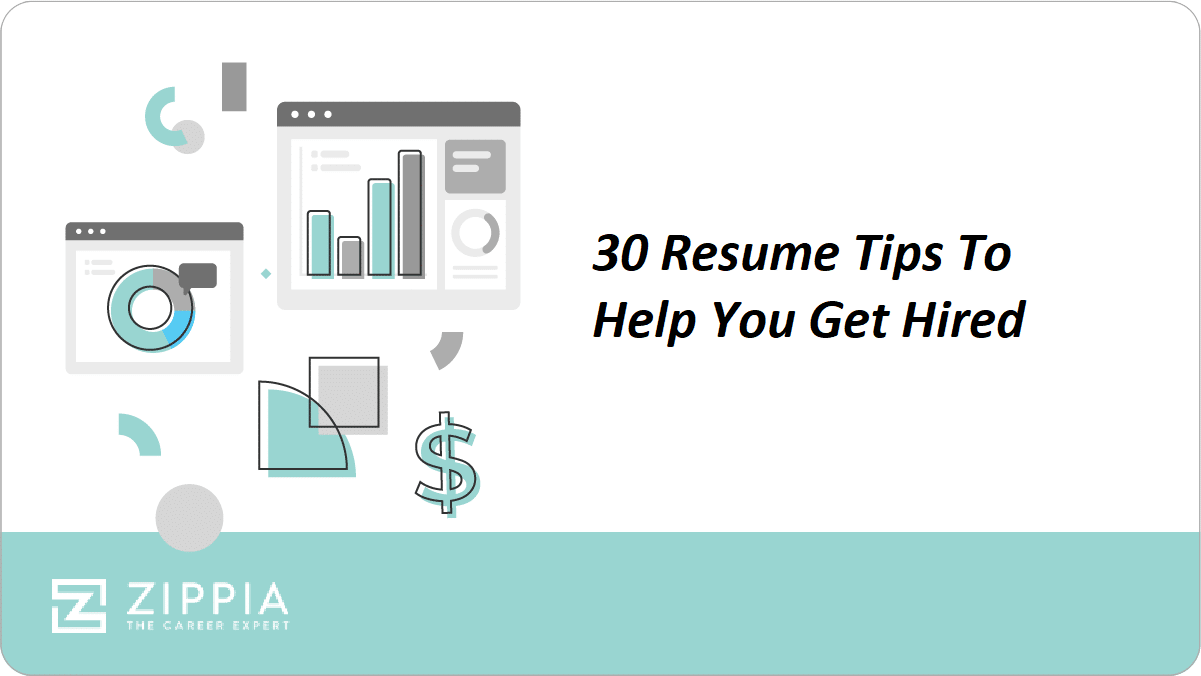
30 Resume Tips To Help You Get Hired

How To Show Your Experience On A Resume… Even When You Don’t Have Any

Differences Between A CV Vs. A Resume

How To Make A Resume (With Examples)
- Career Advice >
- Projects On Resume

Build my resume
- Build a better resume in minutes
- Resume examples
- 2,000+ examples that work in 2024
- Resume templates
- Free templates for all levels
- Cover letters
- Cover letter generator
- It's like magic, we promise
- Cover letter examples
- Free downloads in Word & Docs
20 College Student Resumes + Complete Guide
- College Student Resumes
- College Student Resumes by Role
- College Student Resumes for Academics
Writing Your College Student Resume
Companies sometimes require that entry-level candidates have experience, but how do you get experience when even entry-level jobs make it difficult to apply?
Getting that first job or internship can be the most challenging part of your career. Fortunately, as a college student, you’re in a great position to get that first break you need. Once you get your degree, you’ll have the experience employers are seeking, but until then, how can you build an effective resume or write a cover letter as a college student?
After reviewing countless resume samples , we’ve determined what types employers want to see from college students. Furthermore, we used that knowledge to create 20 college student resume examples to help inspire your resume in 2024 .
College Student Resume Example
or download as PDF
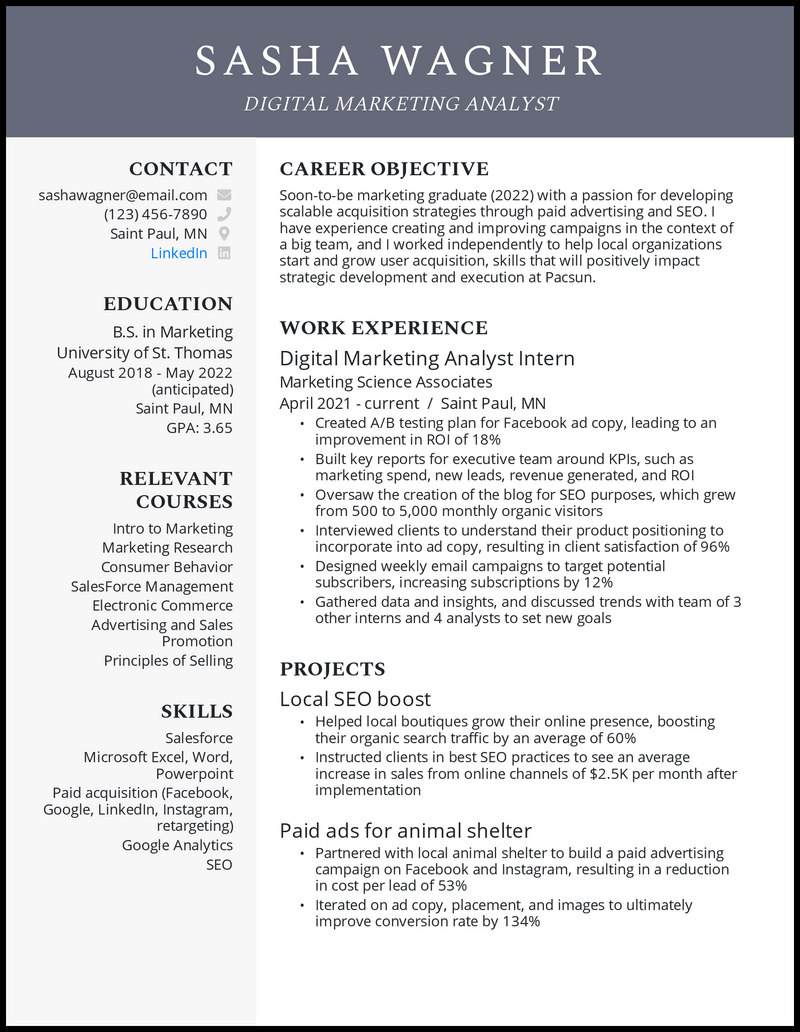

Why this resume works
- This lets employers know when you can work full-time. Whatever you do, be honest. Stretching the truth won’t get you any points with employers. It’s better to be upfront and willing to learn a skill rather than try to succeed by the skin of your teeth.
- The golden rule on your college student resume is to lead with your strengths. If you’ve got a relevant internship, add it. If you’ve done any related class projects, list them. No matter what you include, make sure to highlight transferable skills.
Undergraduate Student Resume

- To impress the recruiter, demonstrate the dedication you have had in your previous posts despite minimal experience.
University Student Resume

- In that case, your university student resume can capitalize on your analytical skills, which helped identify cost-saving opportunities and cut overall expenses by six percent.
College Student No Experience Resume

- Luckily, there are a host of resume templates you can use to format your experience well, so long as you adjust based on your qualifications.
- For example, you can add or remove sections based on the amount of work history you have (or don’t have).
- For example, being on the club basketball team may feel irrelevant to business analysis. But by focusing on how you’ve organized practices and led a local volunteer effort, your college student no experience resume can point to qualities that might appeal to a thoughtful employer.
Current College Student Resume
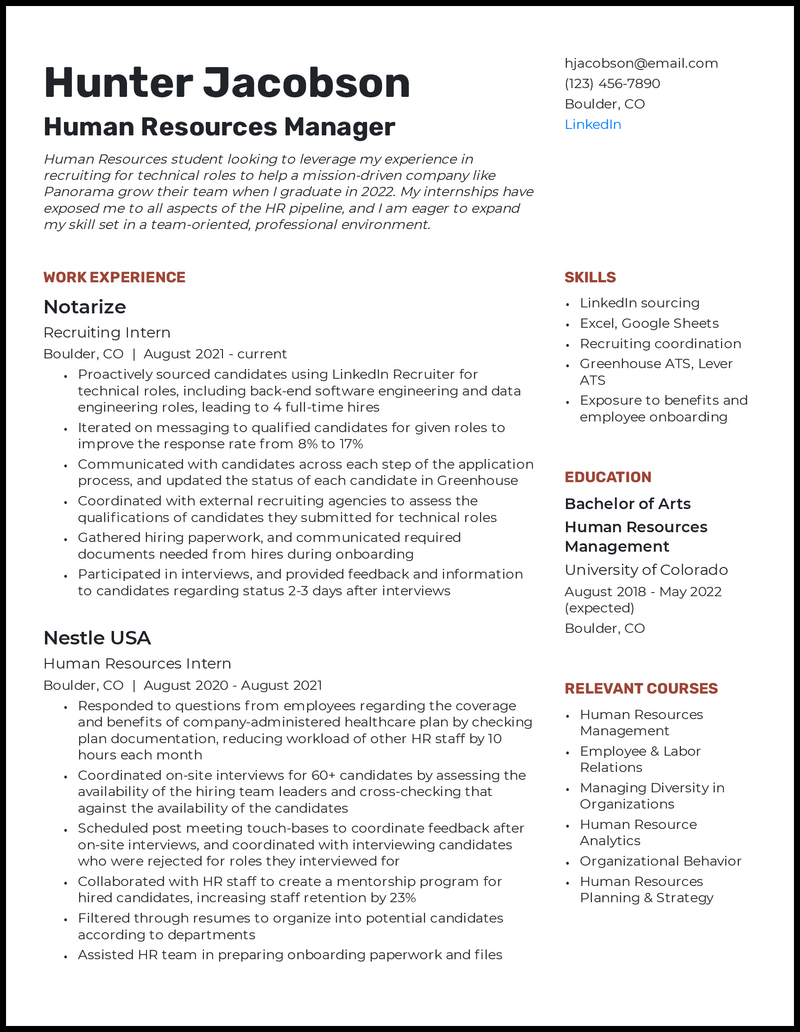
- A reverse-chronological format is still the most accepted, but if you want to highlight your skills, try using a functional format instead.
- Adding relevant metrics shows that you know what matters to your employer and you’ve positively impacted your previous workplace.
College Student for Internship Resume
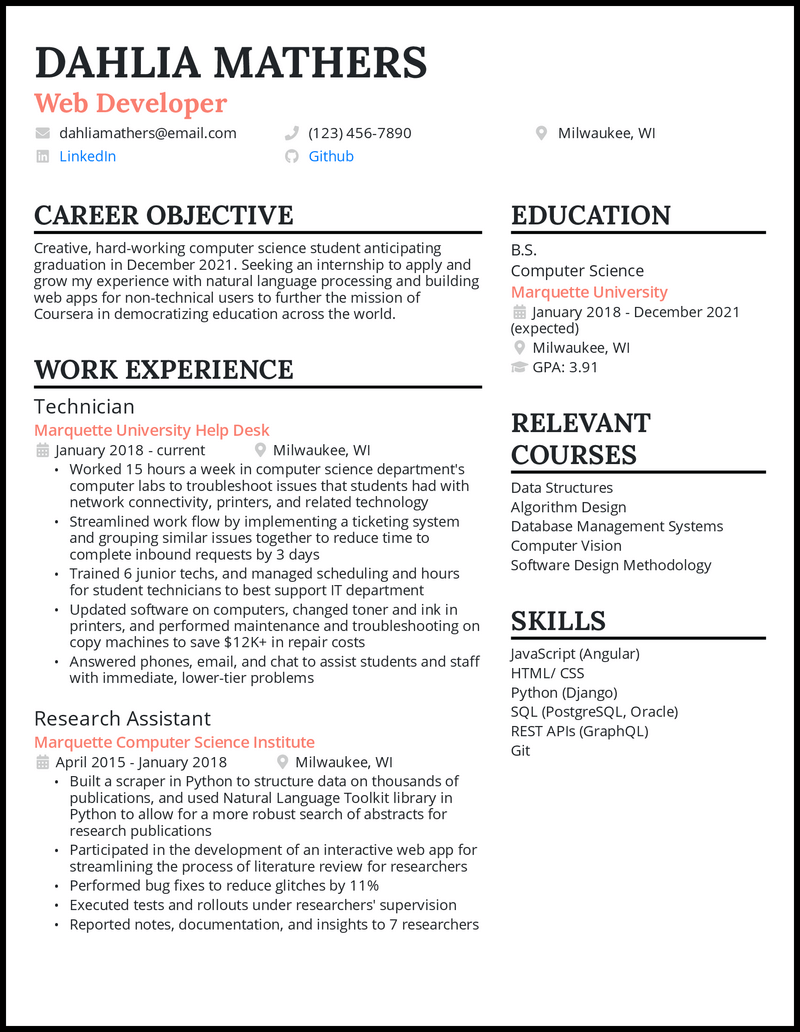
- That’s okay—you can weave in other things, like projects and part-time jobs. Of course, if you do have internship or job experience, put that at the top.
- It’s as easy as checking the job description . Then just list your relevant abilities according to what matches the keywords listed by the employer.
College Student Assistant Medical Laboratory Technician Resume Example
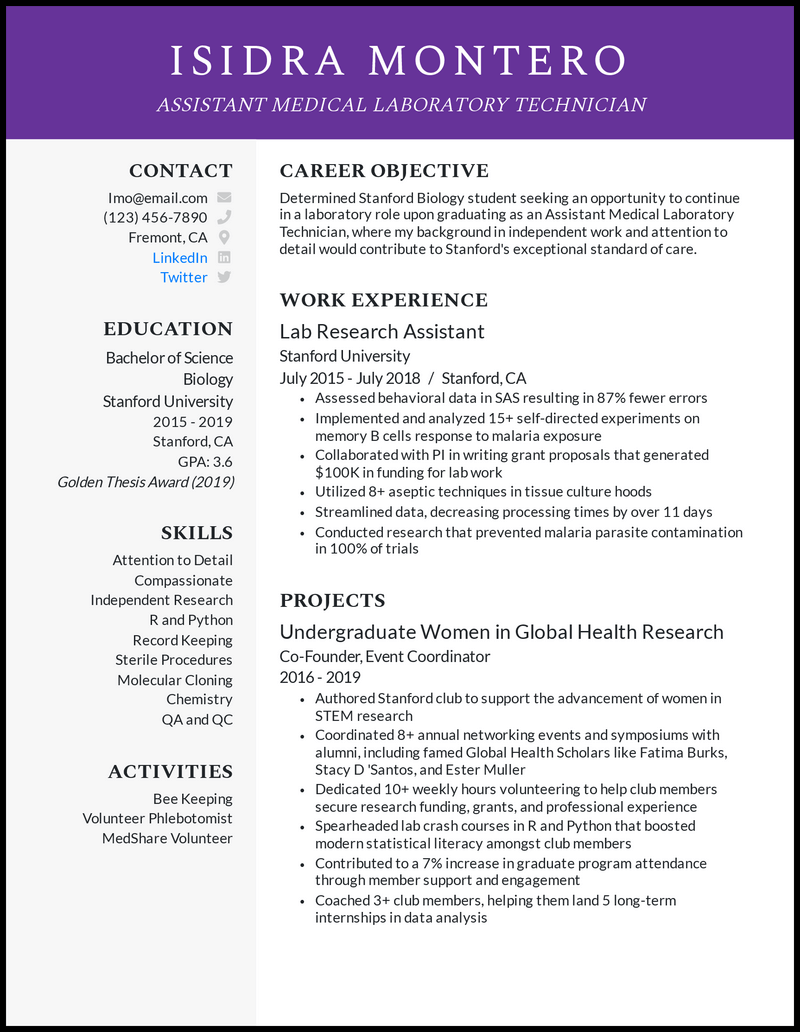
- Do you have a unique interest related to science? Are you involved in a sport? Do you volunteer? All of these hobbies are great additions to your resume.
- If you’ve just graduated, you can bulk up your education section.
- Feel free to add any college awards you won and your GPA (if it’s higher than 3.5).
College Student HR Executive Assistant Resume
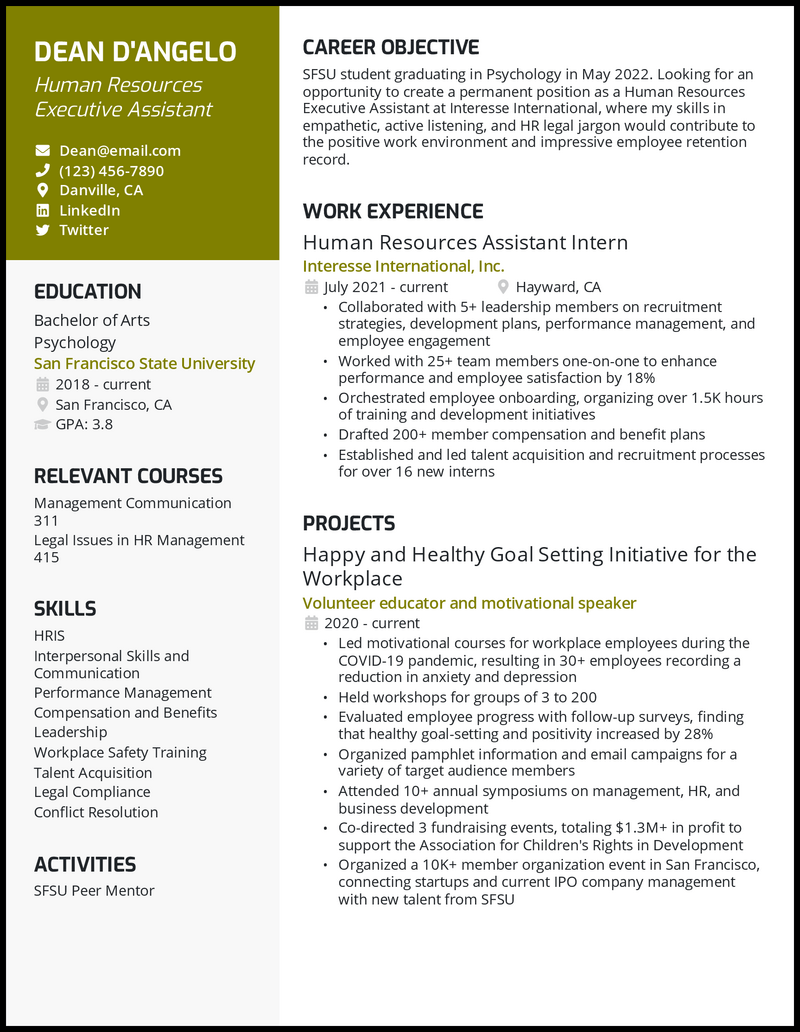
- As a rule of thumb, we recommend including one if you’re light on experience or are going through a substantial career change. Otherwise, leave it out in favor of work experience.
- Good skills to include on an HR executive assistant resume are “talent acquisition,” “conflict resolution,” “legal compliance,” and “compensation/benefits.”
- An even more effective way to breathe life into your skills is to weave them into your work history or project bullet points.
College Student Case Assistant Resume
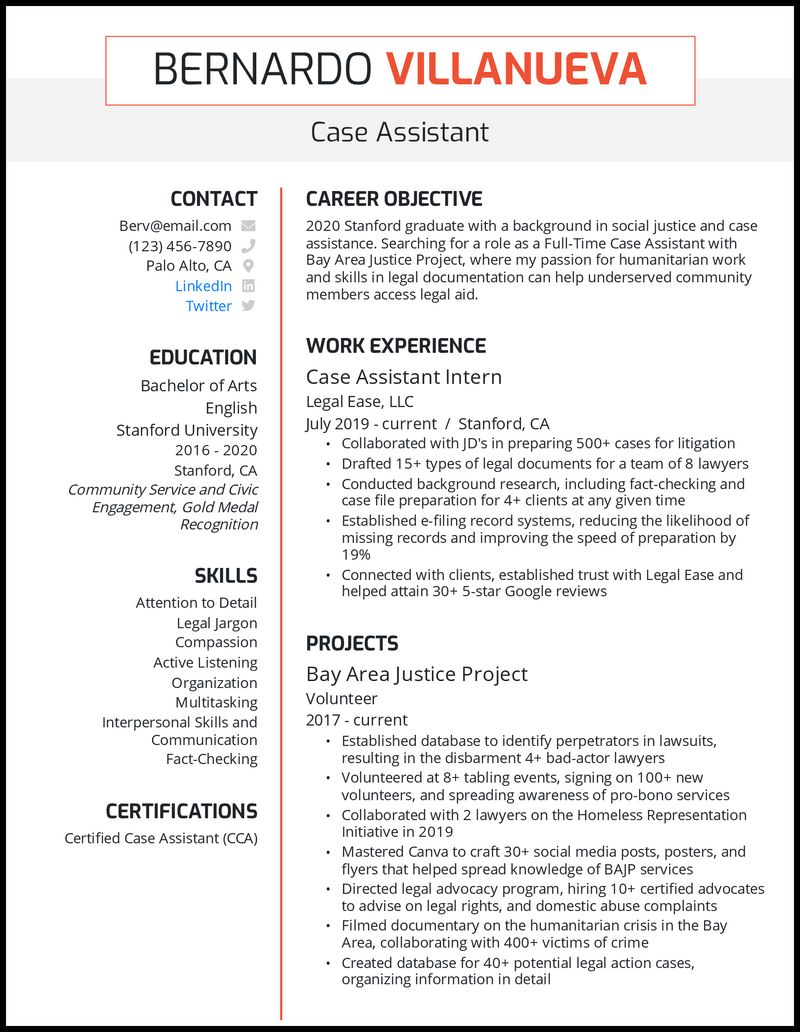
- Show off your personality using contrasting colors, classic fonts, and well-organized layouts. Our ready-to-build resume templates or handy Google Docs interactive resumes can help you keep your resume both tasteful and personable.
- If you don’t have certification, then now’s the best time to get it. Better late than never!
College Student Resident Assistant Resume

- Though an objective isn’t required, it can help employers see your skills and experience straight away.
- Just make sure to tailor it for every job you apply for by including the name of the employer, the position you’re seeking, and some matching keyword skills (that are true about you) gleaned from the job description .
- You also shouldn’t feel limited by your work experience. If you’ve done any relevant projects or have volunteered, include them! Employers love to see transferrable skills like collaboration, a good work ethic, and organization.
College Student Warehouse Worker Resume

- If you’re struggling to get going, consider using a resume outline to help you structure your experience—just don’t forget to fill out all the sections thoroughly!
- While it’s not impossible to land an excellent job without internships or experience, having some kind of work history, even in the form of projects, will allow you to be more picky and skim from the top of warehouse positions.
College Student Teacher Assistant Resume
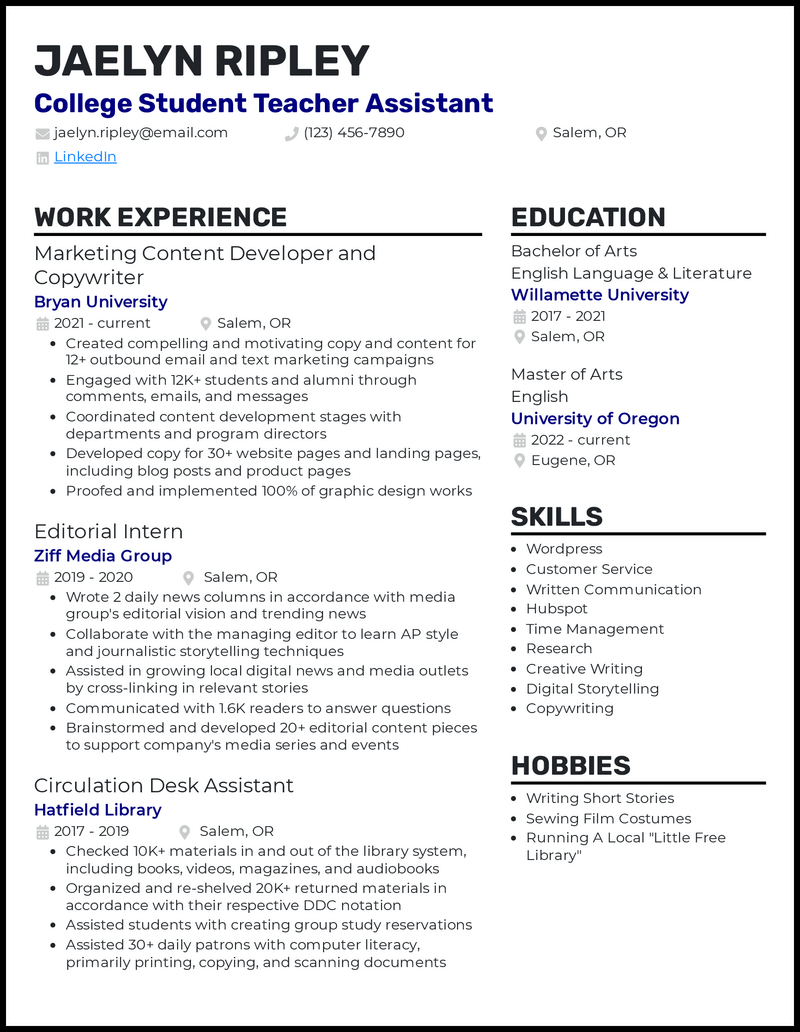
- Adjusting formatting details, like the layout and header colors, can make your resume pop and reveal a bit about yourself. (Red and pink are bold, daring colors, while blue and green are calming.)
- Adding a hobbies and interests section to your resume can also help catch the eye of employers, provided you list hobbies that are relevant to the desired job, such as creative pursuits, volunteering, or research.
- Even if you’ve never had experience as a teacher assistant, you can instill confidence by demonstrating the impact of your communication skills. Did you effectively resolve an issue using negotiation? Write something that added helpful clarity? Show how you used communication to affect others positively!
College Student Biology Lab Technician Resume
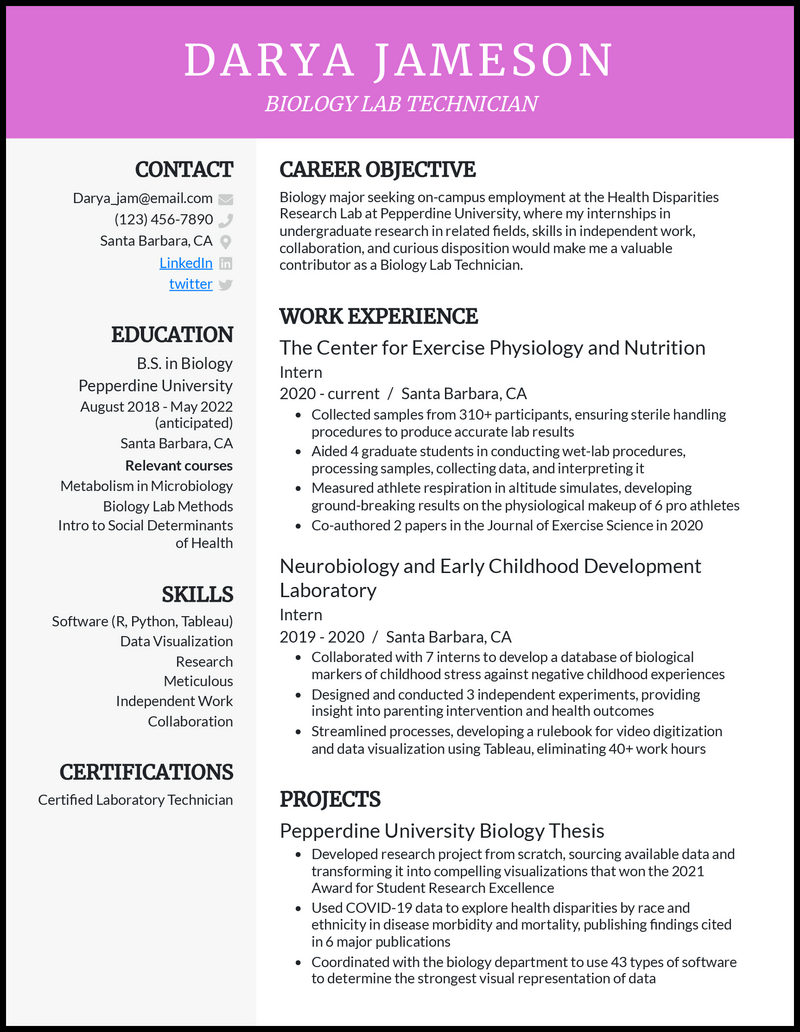
- Don’t get too carried away here; after all, it’s still a resume and not a flier for a Wednesday Night Disco. But, one to two colors can be appropriate for all but the most conservative working environments.
- Numbers can be frustrating to calculate and add to your resume, but trust us when we tell you that they make a world of difference. Hiring managers are consistently more willing to interview people with metrics on their resumes, as they convey job competence and confidence.
College Student English Tutor Resume
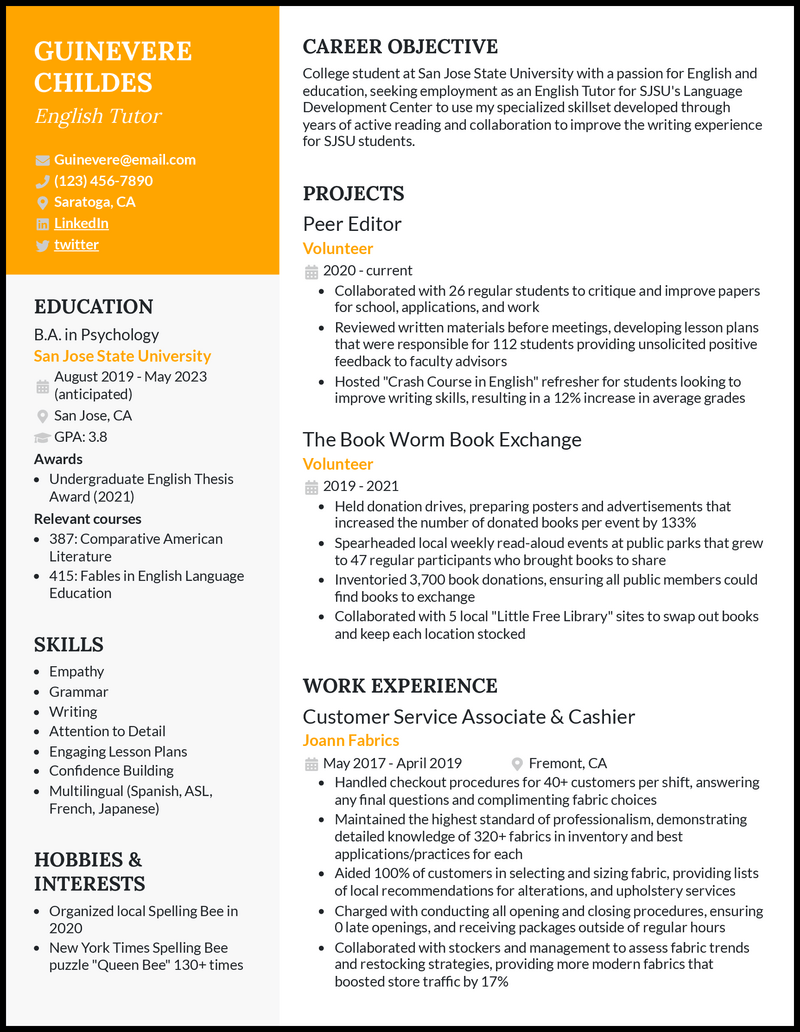
- Breaking up each work experience into bullet points can make your resume both easier to read (with fewer blocks of dense text) and easier to write.
- Instead of writing one big chunk of cohesive text, you can focus on pulling out as many highlights about your work history at each job as possible.
- A project can be anything. Seriously, your final group project from that writing seminar counts, or you could highlight a blog you’ve been working on in your free time.
- Hint: Projects also make great stories to discuss on your college student cover letter .
College Application Resume

- Suppose you’re applying for a Bachelor of Arts in education. Express your passion for teaching and eagerness to advance your knowledge of education theories and practices. Even better, emphasize your long-term ambition to shape future generations through innovative education methods.
College Admission Resume

- Take a leaf from how Brian narrates his stints as a restaurant server, project presenter, and volunteer. Well-described, such experiences paint a picture of a well-rounded character who can take on varied challenges of an engineering program, enhancing their appeal in the eyes of the college admissions committee.
College Freshman Resume

- Use past projects to advantage here even if they’re only a year long. Clearly state how you used skills such as Canva and Microsoft Teams to make specific impacts during this time. Another great addition to your college freshman resume is any work experience under your belt.
College Student Academic Highlights Resume

- Say you have some work experience, but it’s not relevant to the job. That’s okay—instead of trying in vain to match the job description , focus on transferable skills like customer service, organization, event planning, public speaking, and computer literacy.
- If you lack much work history, adding projects, coursework, or volunteer experience is the next best way to showcase your potential. You can also list your involvement in clubs, organizations, or peer mentorship.
- Write them like you’d write work experience by using active verbs and incorporating metrics (numbers).
First Year College Student Resume

- Your time contributing to a project is tangible evidence of your skills and experiences. Depending on what you include, it could showcase your communication and organizational skills or more technical abilities, like your proficiency with Microsoft Office.
Freshman College Student Resume

- Do you love gardening or nature photography? Awesome, it shows you’re inherently passionate about biology. Do you spend your time baking as well? It’s a sign that you know how to follow instructions and observe changes over time—skills that will come in handy as a lab assistant.
Related resume guides
- College Graduate
- Grad School
- Entry level

Before we dive into the difference between a resume objective vs. a resume summary , let’s get some definitions out of the way:
- Resume objective : A statement of your qualifications, interests, and skills that make you a good fit for the role to which you’re applying.
- Resume summary : A summary of your past experience detailing your high-level accomplishments and projects.
When you’re applying for a job or internship as a college student, you likely won’t have extensive work experience. So, we’d recommend including a resume objective instead of a resume summary.
The goal of your resume objective is to set the stage for your resume. It should highlight your skills applicable to the job at hand, and it should be specific for each job to which you’re applying.
Most resume objectives are boring and generic. By taking the time to craft a customized and effective resume objective, you give yourself an edge over other applicants and increase your chances of getting an interview.
Before we dive into the rules for creating a strong resume objective, let’s look at some examples.
Sample college student resume objectives
- “Recent college graduate with a degree in marketing looking for a full-time role where I can utilize my experience in social media and paid advertising to help an up-and-coming brand like Club Z! Inc. spread awareness and acquire more users.”
- “Diligent college student at the University of Pittsburgh who is equally committed to academic excellence (3.8 GPA) and service (student leader at the local food shelter) looking for an opportunity at Unidos as a part-time employee to utilize these talents to improve customer satisfaction.”
- “Recent graduate with a Masters of Business Administration (MBA) seeking an opportunity within an established management organization to utilize my organizational and quantitative abilities. Epic seems to have a culture of empowering employees to have ownership over their problems, and that culture fits my work style perfectly.”
You can see that all of these resume objectives specifically mention the company that the student is applying to. Tailoring is the golden rule of resume objectives.
Here are some other rules to make your objective the best it can be:
- Again, take the time to customize your resume objective for each company to which you’re applying .
- Don’t be afraid to inject your personality. Making an impression will help you stand out among the hundreds of other applicants.
- Keep it to two to three sentences.
- Mention any relevant skills or certifications you have for the role to which you’re applying.
College Student Resume Formats

One of the hardest parts of using a resume maker as a college student is the blank page. The “getting started” part is overwhelming—you’re unsure what your resume should look like, let alone what should be in it!
When it comes to formatting your resume, the best advice is to keep it simple . You need to convincingly make the case that you deserve an interview for the role to which you’re applying.
In short, your resume should likely contain the following sections:
- Header: This is your name and job title. Have your job title match the job title to which you’re applying.
- Resume objective: We talked about this above, a quick summary of your skills and what you’re seeking.
- Education: As a college student, this should include your anticipated graduation date, the field of study, and relevant classes.
- Skills: List six to ten technical skills relevant to your career.
- Work experience: If you have any relevant internships or part-time jobs, mention them here.
- Projects: Did you do any side projects that demonstrate your competency? Include them!
Not all of these sections need to be included in your resume. Your resume should focus on your strengths.
If you don’t have much relevant work experience, you can omit that section in favor of discussing your projects or classwork.
However, no matter what format you choose, there are a few writing guidelines you should adhere to throughout your resume.
Formatting guidelines for your resume
- Keep your resume to one page! Your resume should only extend to a second page when you have 10+ years of experience.
- Avoid any spelling or grammar errors by double-checking your text and having a friend review your resume. Don’t let typos be the reason why you don’t get an interview.
- Break up your work experience into small, consumable bullet points. Nothing is harder to read than a big wall of text.
- Use reverse-chronological order to keep your most recent experience/projects at the top.
- Don’t include fancy images or graphics. It’s highly likely a computer will read your resume before a human ever does, and images are hard for computers to scan.
- Don’t list more than ten skills on your resume. (We’ll expand on this below.)
Skills to pay the bills
When building your skills section, it can be tempting to list any and every skill you know. You’ll have to resist this temptation.
Before a human reviews your resume, an automated system called an Applicant Tracking System (ATS) will score your resume based on whether or not it includes the “right” keywords. These filters are largely screening for specific skills.
Doesn’t this mean that you should include as many skills as possible to beat the ATS? Unfortunately, you need to make your resume appealing to both the ATS and a human, and nothing is a bigger red flag to a hiring manager than a candidate with a laundry list of skills!
You’re much better off focusing on six to ten skills you’re an expert in than including more that you kind of know. Generally, if you wouldn’t be comfortable being interviewed on a given skill, don’t include it on your resume.
Work Experience and Projects

In any resume, no matter the career stage, your work experience and projects should take up at least 70 percent of the overall space. These will decide whether you get an interview or not.
Once you have a few years of experience, then the size of your projects section will decrease as the size of your work experience section expands.
If you have an internship relevant to the job you’re applying for, this should be listed in your “work experience” section. As a college student, your work experience can also contain any part-time jobs you had while in school, even if they don’t seem relevant to the position to which you’re applying.
It’s not easy to balance work and school, so having a part-time job demonstrates responsibility and drive.
When talking about your work experience, there are a few key tips you should follow:
- Mention the skills you demonstrated on the job.
- Quantify the impact of your work whenever possible.
- Talk specifically about your role; avoid being too general.
- Use action verbs like “owned” or “led” to highlight your leadership abilities.
Numbers truly speak louder than words, especially on your resume. By providing numerical context around your work, you show your ability to contribute meaningfully to your workplace.
Compare these two descriptions of an internship. Which do you think would be more compelling to a hiring manager?
WRONG – general work experience descriptions
Marketing Science Associates April 2020 – Current, New York NY Digital Marketing Intern
- Created testing plan for Facebook ad copy
- Built key reports for the executive team around KPIs
- Oversaw the creation of the blog for SEO purposes
- Worked closely with clients to understand their product positioning to incorporate into ad copy
RIGHT – specific, quantified descriptions
- Created A/B testing plan for Facebook ad copy, improving ROI by 15%
- Built key reports for the executive team around KPIs such as marketing spend, new leads, revenue generated, and ROI
- Oversaw the creation of the blog for SEO purposes which grew from 1,000 to 5,000 monthly organic visitors
- Worked closely with clients to understand their product positioning to incorporate into ad copy, leading to client satisfaction of 99%
Projects can be anything
If you don’t have much (or any) relevant work experience for your resume, don’t fret. You can still create a highly effective resume by showcasing your projects.
As a college student, you’ve likely done a lot of class projects that are relevant to the job or internship you’re looking to get. This is the perfect place to talk about those projects. You can even mention projects you completed outside of class. Talk about your goals, the methods/skills you used, and the project’s outcome.
The key is to include anything that will convince the hiring manager you have the drive, skills, and ability to translate your academic knowledge to the real world and contribute to the roles for which you’re applying.
Here are some potential projects you can work on for different majors:
Project ideas for college students
- Are you a business student? Detail a case study that you analyzed and presented in a class.
- If you’re a marketing student, you can write a short blog post about how you’d improve the paid marketing strategy for a company you admire.
- As a graphic designer, this is a great opportunity to talk about some of the projects in your portfolio.
- If you’re looking for a data analyst role, talk about how you analyzed stock data to determine areas of opportunity.
- As a human resources major, you’ve likely created processes for companies as part of a class, so talk about that.
- Software engineering students complete meaningful coding assignments all the time. Discuss one of those or talk about your side project.
- If you’re looking to break into product management, discuss a hackathon you were part of or create a case study for a feature your favorite product is missing.
Basically, the projects you include on your resume can be just about anything. They simply have to demonstrate you know what is required of the kind of role you’re applying to, and that you can meet those requirements.
Your Education Section

As a college student, it should go without saying that you need to include an education section on your resume.
Here’s what you need to include in your education section no matter what:
- The school you’re currently attending (or recently graduated from). You do not need to include your high school.
- Your graduation date (or expected graduation date). You can give just the month and year.
- The kind of degree you’re working toward (bachelor of arts, bachelor of science, master’s, etc.).
- Your field of study.
Once you include all that, there’s more flexibility. If you have a strong GPA (greater than 3.5), you should include it, too.
If you don’t have much experience yet, then you can add relevant courses or awards to your education section, provided they’re relevant to the job for which you’re applying.
For example, if you’re applying for a role as a data scientist, then it makes sense to include any math, economics, or programming classes you completed.
Here’s an example of an effective education section for a college student looking for a marketing role:

If you received any awards or honors during your time in college, list them here. These can include getting on the Dean’s List, any department-specific awards relevant to your major, or formal recognition for your work or volunteer efforts.
Resume Builder for College Students

There you have it—we’ve discussed the building blocks to help you land a job or internship as a college student!
In summary, here are the keys to making an effective resume as a college student:
- Inject your personality into your resume objective and customize it for each company to which you apply.
- Your resume format should include a header, resume objective, skills section, education, and work/ project experience.
- Include any relevant internships or part-time jobs you’ve had during college and quantify the impact of your work.
- If you don’t have much working experience, include relevant projects you’ve completed either in the classroom or on your own time.
- Your education section is your chance to highlight classes you’ve completed that will convince the hiring manager you have the right tools for the job.
Finding a job or internship as a college student can be incredibly stressful. Building an AI resume is a huge first step, so pat yourself on the back. After you’re done with the writing, you can check your resume against our AI-powered tips to see how your resume matches up.
Just remember, it does get easier after you get some experience first. We can’t wait to see where you’ll go!

• We’ll show you how, step-by-step • Real, practical tips and tools • 100% free

IMAGES
VIDEO
COMMENTS
How to put projects on a resume. There are two methods you can use for adding projects to your resume: List your projects in separate bullet points or short paragraphs beneath each work experience and education entry; List your projects in a dedicated section on your resume
Adding school, work, and side projects is a great way to fill qualification gaps on your resume—as long as you’re selective and do it right. Plus examples!
How to add projects to your resume. Since you want to keep your resume relevant to the job you're applying for, the first step is to create a list of projects from your history and compare them to what employers need. Analyze the job description to dissect out the keywords and phrases.
Listing projects on your resume will help you get a leg up over other qualified competing applicants. A project-based resume, similar to a functional resume, is highly effective in conveying your unique qualifications, work style, field of specialization, and areas of expertise.
Looking to land an internship or job in 2024? These college student resume samples & guide are proven to help, no matter your experience.
Jamie Birt. Updated July 3, 2023. On your resume, you may decide to highlight various school or work projects you've contributed to or completed. This can allow hiring managers to see your capabilities and determine whether your working style would make you a good candidate for the company.